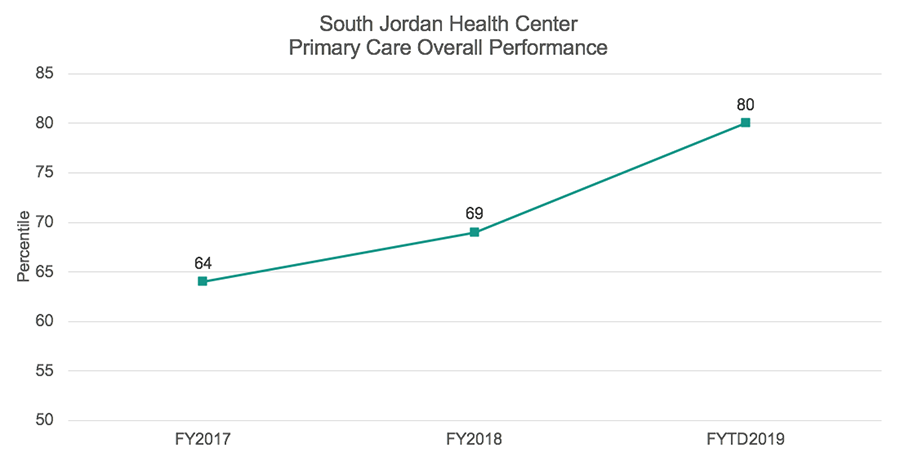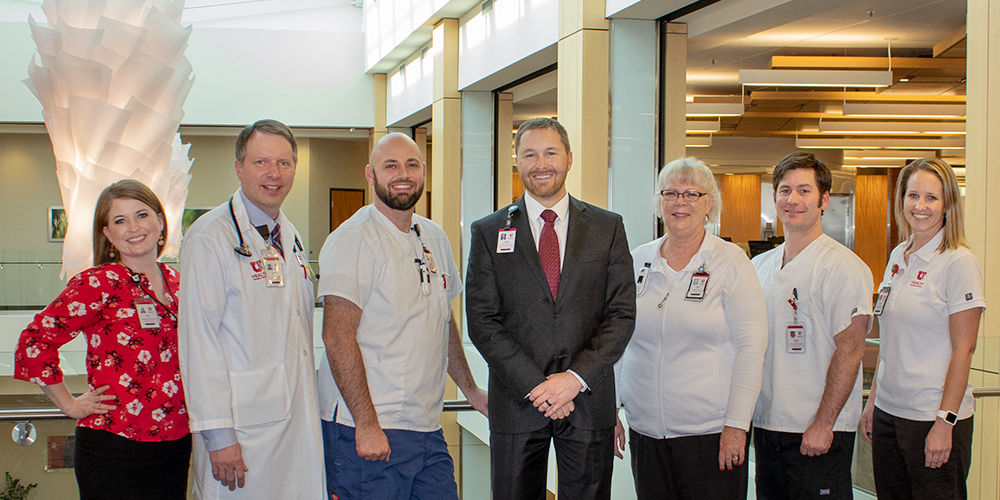hrough my experience, I have noticed an interesting connection between culture, employee engagement and patient experience. Having a high-performing culture and great employee engagement helps your team conquer challenges.
Before I came to University of Utah Health, I managed a private ophthalmology clinic. Shortly after accepting the job, I quickly learned that the team was in really bad shape. I found bullies, fighting, scandals and burnout–all the qualities of a great movie! The first step in turning around the team was to find a shared purpose: doing the right thing for each patient.
I came to University of Utah Health because I was impressed by its commitment to patients. The principles and tactics I learned from my work in ophthalmology have helped me shape culture and achieve success at multiple health centers.
1. It starts with engagement
Over the course of my career, I’ve worked with a few teams that had negative, low-performing cultures. Each time, I found myself asking questions about employee engagement. What motivates each team member? Who are the emotional leaders? How do we build trust? Where is their focus? What can bring people together? What does success look like? Who should be on the team? How do we tap into each employee’s discretionary energy?
Start with why and start with yourself
I like to help people and I try to provide the best work environment for everyone on my team. To me, an engaged employee is an individual who is emotionally dedicated and motivated to work here. They believe in the team’s definition of success and actively work toward that goal.
Sometimes it is easy to get caught up in the complexity of health care and forget why we first wanted to work in this industry. Reflecting on why you entered this field and why it’s important to stay, can help you become a resilient, focused leader. Helping your team members to identify why they are here can be just as profound. It is worth the time to talk individually with each team member about why they work here.
"By helping your team members discover their why, you are helping them connect to their innate purpose. Having purpose is energizing. When people have purpose, they develop an internal compass for making better decisions and they become more self-motivated and resilient."
By helping your team members discover their why, you are helping them connect to their innate purpose. Having purpose is energizing. When people have purpose, they develop an internal compass for making better decisions and they become more self-motivated and resilient. This will help the right people on your team start the journey of being emotionally dedicated to the team and to you as a leader.
Tap Into Intrinsic Purpose
Helping individuals identify what success means to them is a natural extension of the conversation. I often ask people what they are proud of at the end of the day. What tasks give them energy? This helps employees take pride in their work and recognize how rewarding it can be to help patients live happier, healthier lives.
When your team members perform well, take a minute to reinforce that positive behavior by sincerely thanking them. Whether by a thank-you note, a genuine conversation of gratitude or a small token of appreciation, showing gratitude is an investment in a person’s emotional wellbeing. When employees feel valued, they become great allies in building an exceptional culture.
When you tap into a person’s intrinsic purpose to be here, he or she becomes more motivated and willing to give discretionary energy. This extra energy often produces better patient interactions, better co-worker interactions and a better team culture. When employees voluntarily give this energy, your team will find ways to succeed.
2. Set limits
Rules of engagement
People like rules of engagement, which help create a solid foundation for shaping your culture. Structure helps improve the team’s resiliency by outlining what is acceptable behavior. I like to ask my team members about their interactions with others on the team. On a high-performing team, there is no place for gossip, drama or chronic complaining. Creating a pleasant, safe environment for everyone on the team will help your high performers stay focused and really shine.
The PROMISE standards were created to give teams rules of engagement. Every month we highlight an area of the PROMISE standards so the team knows what is expected. We also take time to celebrate a few team members that exemplify these standards in their work. The nominations come from the team members, not leadership, and are placed in the break room on what we call our PROMISE board. This reinforces the standards and helps the team to have successful behaviors.
When to say goodbye
Just as high performers can take your team to new highs, a low performer, who would rather ensnare your team in drama and negativity, can sink your team’s performance. If you’re not careful, a low performer can sink your career as a leader. To help the team function at a high level, removing the right individual is sometimes needed. Most of the people that I have removed were actively working against team goals, unwilling to learn the skills needed for the job, or highly motivated to create a destructive work environment.
When any of these situations happen, take immediate action to correct the behavior or remove the person responsible. It is your responsibility to protect your culture and your team members. Ultimately, when a person leaves the team, it is a great opportunity to find a new high performer that can help you build a safe work environment and a strong culture centered on helping patients.
3. Share the lead
Communication is an important part of engagement
Within my leadership team meetings, we have a lot of conversations regarding solving problems and achieving our goals. Because we may have differing points of view, I encourage others to share their opinions. Having a safe place to discuss disagreements is important. Doing so will help you find effective, sustainable solutions that everyone can support.
I find it fascinating when my leadership team is working on a problem and I bring one idea, then another leader shares a different idea, and so on, until, during the discussion, a whole new idea is born that is better than all the original ideas. This idea generation is possible because everyone in the room feels valued and is encouraged to contribute to the process.
No one can do this work alone, and no single leader has all the right answers. You have to lean on and learn from your team. I’ve been fortunate to work with great medical directors (currently David Owen ), nurse supervisors and admin assistants. I’ve also had great mentors to guide me along the way. Having a solid leadership support group makes my job very rewarding on multiple levels.
Once you have engaged employees, a safe work environment, and a culture that puts patients first while valuing hard work, trust and loyalty, then your team is ready to succeed.
The result of hard work and high engagement

Press Ganey overall for primary care providers at South Jordan Health Center; UHC benchmarking by received date.
Source: Jared Wrigley, Manager.
Supporting the practice of clinicians
Pati Colvin (manager at Redstone Health Center) gave us a great idea to hold quarterly reviews with each provider. A quarterly review includes the provider, medical director, operations manager and nurse supervisor. It typically takes 15 to 30 minutes.
The Game Plan: Ask about the provider’s wellbeing. Discover any areas that might cause them frustration. Understand and deliver any additional support the provider needs. Review the performance of the provider’s practice. Give select patient feedback. Look beyond the percentile to the frequency analysis to identify all the areas that are going well, and one area that needs some attention. Offer possible solutions and talk it over with the provider. Share wonderful patient stories and point out specific behaviors that patients like and find helpful during their visits.
Health care is stressful work and feedback from patients helps us build strong, resilient cultures centered on delivering the best possible care to patients.
Originally published February 2019
Jared Wrigley
Meetings often default to logistics, platitudes, or maintaining norms, the Resiliency Center’s Megan Whitlock explains. By thinking of meetings as gatherings we can turn them into a powerful tool to bring about something every workplace needs more of: belonging.
To disagree means failing to agree. Synonyms include to contradict, challenge or debate. Synonyms do not also have to include to argue, quarrel, dispute, bicker or clash. Pediatric intensivist Jared Henricksen shares the best path forward when words become clouded with emotion.
What can 15 years of team-building leadership teach you? A lot. Expressive therapies manager, Holly Badger supervised the Huntsman Mental Health Institute's (formally known as the University Neuropsychiatric Institute) ROPES Course before becoming a manager of UNI's Expressive Therapy program. Here, Holly gives Accelerate a crash course in building community while strengthening a team.
